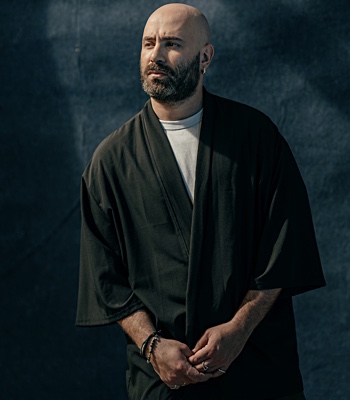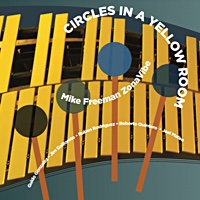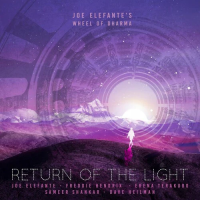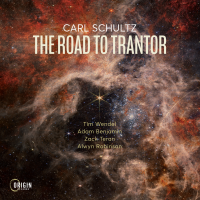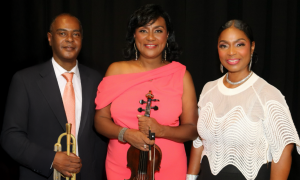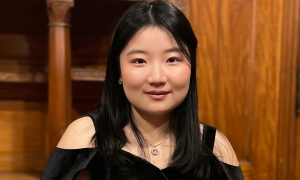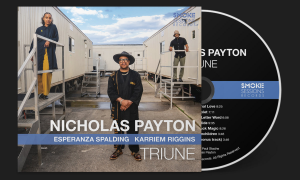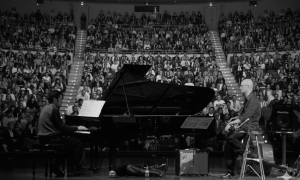By Pico
Here's another half dozen batch of jazz wholesomeness brought to us by both emerging and established artists, from the mainstream to the insane-stream. Half of these are pianoless trios but with entirely different lead instruments, which seems to be a trend among the more adventurous musicians, and these guys can flat out cut it. The Stacks continue to slowly dwindle down as more new releases get their due...
Avishai Cohen Introducing Triveni: Avishai Cohen, the trumpet player, was last seen nearly two years ago in conjunction with his 2008 release Flood, a sparsely configured work where he sought to push against the outer boundaries of jazz using just his trumpet accompanied by only piano and percussion. This year's Introducing Triveni also involves only three players, but the objectives are much different. Going with a more conventional format of bass (Omer Avital) and drums (Nasheet Waits), Cohen is also going back to basics of jazz. Using mostly his own songs as vehicles for improvisation, the band nonetheless never lets it devolve into a straight blowing sessions; the proceedings move along at a natural pace; “Mood Indigo" for instance is played at a lazy pace that favors mood and style over chops just for the sake of chops. Cohen plays with the grace and intellect of Miles, but with the control and dexterity of Woody Shaw (check out his acrobatic ending statements on Don Cherry's “Art Deco" for a showcase of his technical mastery). Of the Cohen originals, the last track “October 25th" is the most exhilarating, as Waits' unpredictability makes the other two react and try to guess where he's taking the tune. Recorded obviously “live in the studio" over two days, Introducing Triveni is the first product of those sessions; a second Triveni release is slated to release next May. Until then, Introducing Triveni provides yet another facet of Cohen's virtuosity to enjoy.
Kenny Burrell Be Yourself: Like another longtime legend Barry Harris, guitar great Kenny Burrell cuts a live disc that proves he's still got what it takes to live up to his immense reputation. Recorded over a week-long engagement at one of NYC's hottest jazz spot's, Dizzy's Club Coca Cola, Burrell assembled a band players young (24 year old saxophonist/flautist Tivon Petticott makes an impressive recording debut here), and vets like drummer Clayton Cameron and Jazz Messengers alums Benny Green (piano) and Peter Washington (bass). Burrell's blues-based lyrical style has been just about as influential as Wes Montgomery—-Jimi Hendrix once remarked “Kenny Burrell, that's the sound I'm looking for"—-and it's almost tempting to dismiss his playing as highly derivative, until you realize he's the guy who other jazz guitarists are copying their style from! The selections here provide a nice assessment of Burrell's career. “Tin Tin Deo" was a tune he recorded with Dizzy Gillespie way back in 1951, and “Raincheck" and “In A Sentimental Mood" continue Burrell's long running love affair with the music of Duke Ellington. Kenny Dorham's evergreen standard “Blue Bossa" is given a more festive treatment than when you usually hear and Burrell suave, soulful solo is all the proof needed of why he's the master. More proof comes on the guitar-only Burrell original “Be Yourself." An apt title for the whole album, too: Be Yourself is Kenny Burrell being who he has been over a nearly sixty year recording career, which is more than enough to make this a fine record.
Fred Fried And Core Core 3.0: Fred Fried comes from the George Van Eps school of guitarists, having been taught by the late guitar great himself. That's readily apparent from his harmonically intricate style that leads with full chordal lines while simultaneously playing the enhancing bass lines. In other words, Fred Fried fingerpicking style, like Eps, has more in common with the piano than conventional guitar. Van Eps expanded his tonal palette to meet his vision by adding a seventh string; Fried goes one better and plays an eight string acoustic for this record. Fried chose to complete his ensemble with his gigging band that has Michael Lavoie on acoustic bass and Miki Matsuki on drums. Also for Core 3.0, Fried chose to play all originals, and all are harmonically interesting: “Melody Four" has an advanced chord progression and I like how the band gradually builds it into a hard swinging jam as Fried simply slays it on his solo. The sweet waltz “Sadie" is a tune isn't a standard but it sure seems like one, and “Leanne's Number" is another example of Fried's knack for memorable melodies that are more complex than they sound. Never over the top but always active, Fred Fried and Core makes an album that makes the case for the relevance and richness of acoustic guitar in modern jazz. At least, when it's done as well as Fried does it.
Purchase: Core 3 0
Jason Stein's Locksmith Isidore Three Kinds Of Happiness: Here's one from the stacks I'm early reporting on (it's due out November 30), but worth chatting up now. Jason Stein is a bass clarinetist who is making waves on Chicago's dynamic improvised music scene. A member of Ken Vandermark's Bridge 61 band as well as minimalist rock collaborations with David Daniels, Stein's own main project is a bass/drums trio he calls Jason Stein's Locksmith Isidore. For this band that includes Jason Roebke on bass and Mike Pride on drums, Stein writes songs modeled after Steve Lacy's tradition-based but freely structured approach. This makes for songs that allow for a lot of extemporaneous expression, a kind of expression often follows the “New Thing" examples of Archie Shepp, late Coltrane, and or course, the great bass clarinetist Eric Dolphy. But Stein doesn't quite replicate Dolphy or any other bass clarinetist: he ventures up in the upper registers more, wavering his notes a little more, sometimes sounding more like Coleman Hawkins than Bennie Maupin. “Crayons For Sammy" and “Little Bird" exemplify this approach well. All the same, he can break from his own tendencies as the situation call for it: the clipped notes and lower register excursions on “Arch And Shipp" make that clear. Three Kinds Of Happiness makes all kinds of sweet noise.
Purchase: Jason Stein's Locksmith Isidore—Three Kinds Of Happiness
The Britton Brothers Band Uncertain Living: Bands led by horn players tend to work well if there's a lot of rapport between the horn players. That's not an issue for The Britton Brothers Band, whose trumpet player (John) and saxophonist (Ben) have the same parents. For this debut, these young cats built a band of other young up and comers, like Brooklyn Jazz Underground recording artist Jeremy Siskind (piano), Taylor Waugh (bass) and Austin Walker (drums). One of the guys Ben took sax lessons from sits in for two of the tracks; his name is Chris Potter. Equally sharing the composing duties with one track contributed by Siskind, the Brothers & Co. run through a program of tunes that swing, groove and bop, often through tempo changes and some harmonic shifts. It's not whack jazz and it's not traditional mainstream jazz, but a “just right" ind of jazz. “Extra Fuzz" is a funky jazz song that unfolds over time without losing it's hard groove. John's arrangement of the traditional Christian hymn “Come Thou Fount" exploits the chemistry between him and his brother as both play seamlessly around each other and together. Although most of the players, including both brothers, are still pursuing advanced studies in music, they've already have graduate degree in the School of Experienced, having played with many of today's established vets. Thus, it means that as good as Uncertain Living is, it will likely keep getting better from The Britton Brothers.
Mario Romano Quartet Valentino: Here's the setup: a successful real estate tycoon suddenly decides to revisit his original passion, music, and pulls in three of Canada's most prestigious jazz musicians and a top-notch producer to make his first record, one full of done-to-death standards. And you're thinking, this is probably going to be a very competent but very boring, vanity project album, right? You'd be wrong. Valentina, by real estate developer and pianist Mario Romano does get the expected lift from guys the caliber of Pat LaBarbera (tenor sax), Mark Kelso (drums), and Roberto Occhipitti (bass), but it's not just that. Romano is legit force on the piano. But the biggest thing going for the album are the arrangements. Sure, they follow pretty much the same chord progressions, but the tempos are more aggressive, the bass lines are often changed up and the players are putting in crisp, enthusiastic performances (Romano himself lets it fly on “On Green Dolphin Street"). A handful of originals find their way here, including Romano's “Those Damn I Love Yous," featuring the vocal talents of Kristy Cardinali. Vocal jazz plopped in the middle of instrumental jazz can often disturb the groove, but in this case, the genteel, “with strings" three minute piece functions as a fresh breather. So, no, Valentino ain't no vanity project. This is serious business. Seriously good, that is.
Here's another half dozen batch of jazz wholesomeness brought to us by both emerging and established artists, from the mainstream to the insane-stream. Half of these are pianoless trios but with entirely different lead instruments, which seems to be a trend among the more adventurous musicians, and these guys can flat out cut it. The Stacks continue to slowly dwindle down as more new releases get their due...
Avishai Cohen Introducing Triveni: Avishai Cohen, the trumpet player, was last seen nearly two years ago in conjunction with his 2008 release Flood, a sparsely configured work where he sought to push against the outer boundaries of jazz using just his trumpet accompanied by only piano and percussion. This year's Introducing Triveni also involves only three players, but the objectives are much different. Going with a more conventional format of bass (Omer Avital) and drums (Nasheet Waits), Cohen is also going back to basics of jazz. Using mostly his own songs as vehicles for improvisation, the band nonetheless never lets it devolve into a straight blowing sessions; the proceedings move along at a natural pace; “Mood Indigo" for instance is played at a lazy pace that favors mood and style over chops just for the sake of chops. Cohen plays with the grace and intellect of Miles, but with the control and dexterity of Woody Shaw (check out his acrobatic ending statements on Don Cherry's “Art Deco" for a showcase of his technical mastery). Of the Cohen originals, the last track “October 25th" is the most exhilarating, as Waits' unpredictability makes the other two react and try to guess where he's taking the tune. Recorded obviously “live in the studio" over two days, Introducing Triveni is the first product of those sessions; a second Triveni release is slated to release next May. Until then, Introducing Triveni provides yet another facet of Cohen's virtuosity to enjoy.
Kenny Burrell Be Yourself: Like another longtime legend Barry Harris, guitar great Kenny Burrell cuts a live disc that proves he's still got what it takes to live up to his immense reputation. Recorded over a week-long engagement at one of NYC's hottest jazz spot's, Dizzy's Club Coca Cola, Burrell assembled a band players young (24 year old saxophonist/flautist Tivon Petticott makes an impressive recording debut here), and vets like drummer Clayton Cameron and Jazz Messengers alums Benny Green (piano) and Peter Washington (bass). Burrell's blues-based lyrical style has been just about as influential as Wes Montgomery—-Jimi Hendrix once remarked “Kenny Burrell, that's the sound I'm looking for"—-and it's almost tempting to dismiss his playing as highly derivative, until you realize he's the guy who other jazz guitarists are copying their style from! The selections here provide a nice assessment of Burrell's career. “Tin Tin Deo" was a tune he recorded with Dizzy Gillespie way back in 1951, and “Raincheck" and “In A Sentimental Mood" continue Burrell's long running love affair with the music of Duke Ellington. Kenny Dorham's evergreen standard “Blue Bossa" is given a more festive treatment than when you usually hear and Burrell suave, soulful solo is all the proof needed of why he's the master. More proof comes on the guitar-only Burrell original “Be Yourself." An apt title for the whole album, too: Be Yourself is Kenny Burrell being who he has been over a nearly sixty year recording career, which is more than enough to make this a fine record.
Fred Fried And Core Core 3.0: Fred Fried comes from the George Van Eps school of guitarists, having been taught by the late guitar great himself. That's readily apparent from his harmonically intricate style that leads with full chordal lines while simultaneously playing the enhancing bass lines. In other words, Fred Fried fingerpicking style, like Eps, has more in common with the piano than conventional guitar. Van Eps expanded his tonal palette to meet his vision by adding a seventh string; Fried goes one better and plays an eight string acoustic for this record. Fried chose to complete his ensemble with his gigging band that has Michael Lavoie on acoustic bass and Miki Matsuki on drums. Also for Core 3.0, Fried chose to play all originals, and all are harmonically interesting: “Melody Four" has an advanced chord progression and I like how the band gradually builds it into a hard swinging jam as Fried simply slays it on his solo. The sweet waltz “Sadie" is a tune isn't a standard but it sure seems like one, and “Leanne's Number" is another example of Fried's knack for memorable melodies that are more complex than they sound. Never over the top but always active, Fred Fried and Core makes an album that makes the case for the relevance and richness of acoustic guitar in modern jazz. At least, when it's done as well as Fried does it.
Purchase: Core 3 0
Jason Stein's Locksmith Isidore Three Kinds Of Happiness: Here's one from the stacks I'm early reporting on (it's due out November 30), but worth chatting up now. Jason Stein is a bass clarinetist who is making waves on Chicago's dynamic improvised music scene. A member of Ken Vandermark's Bridge 61 band as well as minimalist rock collaborations with David Daniels, Stein's own main project is a bass/drums trio he calls Jason Stein's Locksmith Isidore. For this band that includes Jason Roebke on bass and Mike Pride on drums, Stein writes songs modeled after Steve Lacy's tradition-based but freely structured approach. This makes for songs that allow for a lot of extemporaneous expression, a kind of expression often follows the “New Thing" examples of Archie Shepp, late Coltrane, and or course, the great bass clarinetist Eric Dolphy. But Stein doesn't quite replicate Dolphy or any other bass clarinetist: he ventures up in the upper registers more, wavering his notes a little more, sometimes sounding more like Coleman Hawkins than Bennie Maupin. “Crayons For Sammy" and “Little Bird" exemplify this approach well. All the same, he can break from his own tendencies as the situation call for it: the clipped notes and lower register excursions on “Arch And Shipp" make that clear. Three Kinds Of Happiness makes all kinds of sweet noise.
Purchase: Jason Stein's Locksmith Isidore—Three Kinds Of Happiness
The Britton Brothers Band Uncertain Living: Bands led by horn players tend to work well if there's a lot of rapport between the horn players. That's not an issue for The Britton Brothers Band, whose trumpet player (John) and saxophonist (Ben) have the same parents. For this debut, these young cats built a band of other young up and comers, like Brooklyn Jazz Underground recording artist Jeremy Siskind (piano), Taylor Waugh (bass) and Austin Walker (drums). One of the guys Ben took sax lessons from sits in for two of the tracks; his name is Chris Potter. Equally sharing the composing duties with one track contributed by Siskind, the Brothers & Co. run through a program of tunes that swing, groove and bop, often through tempo changes and some harmonic shifts. It's not whack jazz and it's not traditional mainstream jazz, but a “just right" ind of jazz. “Extra Fuzz" is a funky jazz song that unfolds over time without losing it's hard groove. John's arrangement of the traditional Christian hymn “Come Thou Fount" exploits the chemistry between him and his brother as both play seamlessly around each other and together. Although most of the players, including both brothers, are still pursuing advanced studies in music, they've already have graduate degree in the School of Experienced, having played with many of today's established vets. Thus, it means that as good as Uncertain Living is, it will likely keep getting better from The Britton Brothers.
Mario Romano Quartet Valentino: Here's the setup: a successful real estate tycoon suddenly decides to revisit his original passion, music, and pulls in three of Canada's most prestigious jazz musicians and a top-notch producer to make his first record, one full of done-to-death standards. And you're thinking, this is probably going to be a very competent but very boring, vanity project album, right? You'd be wrong. Valentina, by real estate developer and pianist Mario Romano does get the expected lift from guys the caliber of Pat LaBarbera (tenor sax), Mark Kelso (drums), and Roberto Occhipitti (bass), but it's not just that. Romano is legit force on the piano. But the biggest thing going for the album are the arrangements. Sure, they follow pretty much the same chord progressions, but the tempos are more aggressive, the bass lines are often changed up and the players are putting in crisp, enthusiastic performances (Romano himself lets it fly on “On Green Dolphin Street"). A handful of originals find their way here, including Romano's “Those Damn I Love Yous," featuring the vocal talents of Kristy Cardinali. Vocal jazz plopped in the middle of instrumental jazz can often disturb the groove, but in this case, the genteel, “with strings" three minute piece functions as a fresh breather. So, no, Valentino ain't no vanity project. This is serious business. Seriously good, that is.

